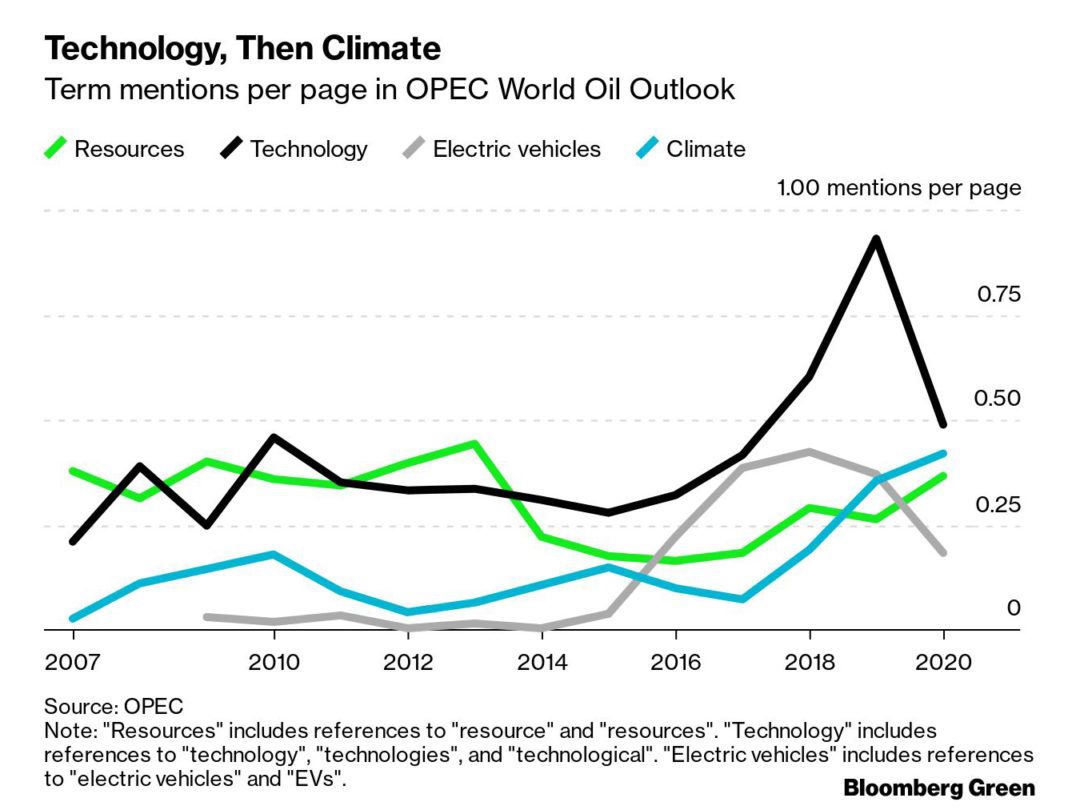
Visit Our Sponsors |
|
|
|
|
|
|
|
|
|
|
|
|
|
|
|
|
|
|
|
|
|
|
|
|
|
|
|
|
|
|
|
|
|
|
|
|
|
|

Oil forecasters have had the same long-term challenge for decades: figuring out how much of the world’s liquid hydrocarbons will be in demand years into the future, and where, and in what mix of products and uses. And for decades, the long-term view has been pretty much consistent: in aggregate, global demand increases as the economy and population grow. Near-term lines are jagged (current oil demand is more than ten million barrels per day lower than it was a year ago, thanks to COVID-19); long-term lines are smooth and moving up.
There’s something different though in the two most recent long-term forecasts, from the Organization of Petroleum Exporting Countries and the International Energy Agency. Those lines, eventually, stop going up. Demand comes very, very close to peaking, even in the most conservative (and for oil, most bullish) scenarios. OPEC and the IEA see demand continuing to grow through 2040, and OPEC even sees 2045 demand very slightly lower than in 2040.
Importantly, though, there are a half-dozen other projections of future oil demand that drop below 2019 levels, sometimes dramatically, thanks to equally dramatic policy interventions. Peak oil demand is also business as usual for some companies heavily invested in oil’s future.
Look closely at the IEA and OPEC’s views of the future, and there is more to it than just “oil demand slowly tops out.” The IEA, for instance, says that coal-fired power generation is in terminal decline, and that by 2040 it will make up less than 20% of global power supply for the first time since the Industrial Revolution. If terminal decline sounds dramatic, that’s because it is. A decade ago, it would have been heretical for the IEA to even suggest such a thing. Even in its 2010 World Energy Outlook, it maintains that “coal remains the backbone of global electricity generation.”
Equally dramatic, if less heretical to technology-minded energy analysts and observers, is what the IEA sees as the cheapest fuel today and into the future. Solar will be “the new king of the world’s energy markets,” says the IEA’s executive director Fatih Birol.
Even though OPEC’s outlook only concerns oil, we should apply some creative thinking to the cartel’s view of energy’s future. I’ve done this before, and last time noted that the components of oil demand growth were already heavily skewed to a few sectors like road transport, petrochemicals, and aviation. COVID-19 has set aviation reeling this year, though road transport has recovered, as has petrochemicals demand in some markets. More importantly, technological developments now make oil’s supremacy less certain, in the same way that solar’s growth and development has changed coal’s growth prospects.
My challenge to those thinking about oil’s future in 2020 is to look at OPEC’s own choice of words over time, and consider how it reflects the factors changing oil’s future. Let us think of mentions as a measure of significance: the more times something is mentioned, the more important it is likely to be for that year’s narrative about energy’s future.
Thirteen years ago, in an age of tight supply, increasing demand, and high and rising oil prices, “resources” — the amount of oil that could be extracted and made available to the market — was mentioned on about one out of every three pages in the World Oil Outlook. “Technology” was mentioned less often, on about one out of every four pages. “Climate” was hardly mentioned and electric vehicles weren’t mentioned at all.
By 2019, “technology” was mentioned more than three times as often as “resources.” Electric vehicles, for that matter, were mentioned more than resources — and “climate” was mentioned more than either of them.
You might notice the sharp downward spike in mentions of technology in 2020 (and a similar, if less dramatic, decline for electric vehicles). Absolute mentions of both dropped significantly, but something heretofore unmentioned appears almost 400 times: the COVID-19 pandemic. It’s only fair that technology and electric vehicles, which at this point are long-term trends for oil, are mentioned relatively less this year. The question for the long term, though, isn’t about a pandemic. It’s about technology, and whether or not oil demand responds to new technologies the way coal is now responding to solar: with structural decline.
RELATED CONTENT
RELATED VIDEOS
Timely, incisive articles delivered directly to your inbox.






